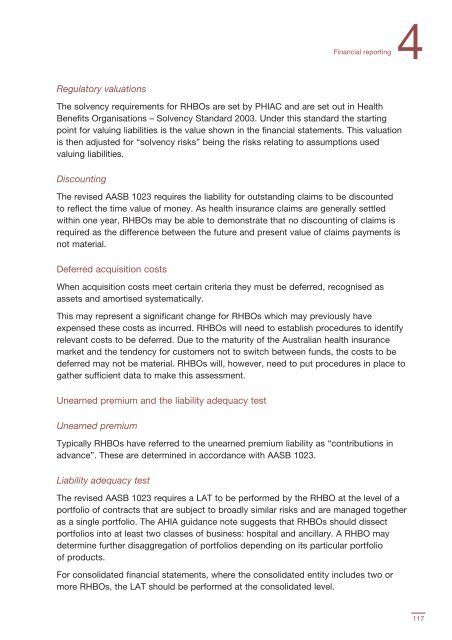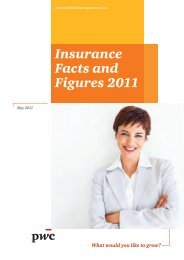Insurance facts and figures 2007 - PwC
Insurance facts and figures 2007 - PwC
Insurance facts and figures 2007 - PwC
Create successful ePaper yourself
Turn your PDF publications into a flip-book with our unique Google optimized e-Paper software.
Financial reporting<br />
4<br />
Regulatory valuations<br />
The solvency requirements for RHBOs are set by PHIAC <strong>and</strong> are set out in Health<br />
Benefits Organisations – Solvency St<strong>and</strong>ard 2003. Under this st<strong>and</strong>ard the starting<br />
point for valuing liabilities is the value shown in the financial statements. This valuation<br />
is then adjusted for “solvency risks” being the risks relating to assumptions used<br />
valuing liabilities.<br />
Discounting<br />
The revised AASB 1023 requires the liability for outst<strong>and</strong>ing claims to be discounted<br />
to reflect the time value of money. As health insurance claims are generally settled<br />
within one year, RHBOs may be able to demonstrate that no discounting of claims is<br />
required as the difference between the future <strong>and</strong> present value of claims payments is<br />
not material.<br />
Deferred acquisition costs<br />
When acquisition costs meet certain criteria they must be deferred, recognised as<br />
assets <strong>and</strong> amortised systematically.<br />
This may represent a significant change for RHBOs which may previously have<br />
expensed these costs as incurred. RHBOs will need to establish procedures to identify<br />
relevant costs to be deferred. Due to the maturity of the Australian health insurance<br />
market <strong>and</strong> the tendency for customers not to switch between funds, the costs to be<br />
deferred may not be material. RHBOs will, however, need to put procedures in place to<br />
gather sufficient data to make this assessment.<br />
Unearned premium <strong>and</strong> the liability adequacy test<br />
Unearned premium<br />
Typically RHBOs have referred to the unearned premium liability as “contributions in<br />
advance”. These are determined in accordance with AASB 1023.<br />
Liability adequacy test<br />
The revised AASB 1023 requires a LAT to be performed by the RHBO at the level of a<br />
portfolio of contracts that are subject to broadly similar risks <strong>and</strong> are managed together<br />
as a single portfolio. The AHIA guidance note suggests that RHBOs should dissect<br />
portfolios into at least two classes of business: hospital <strong>and</strong> ancillary. A RHBO may<br />
determine further disaggregation of portfolios depending on its particular portfolio<br />
of products.<br />
For consolidated financial statements, where the consolidated entity includes two or<br />
more RHBOs, the LAT should be performed at the consolidated level.<br />
117
















